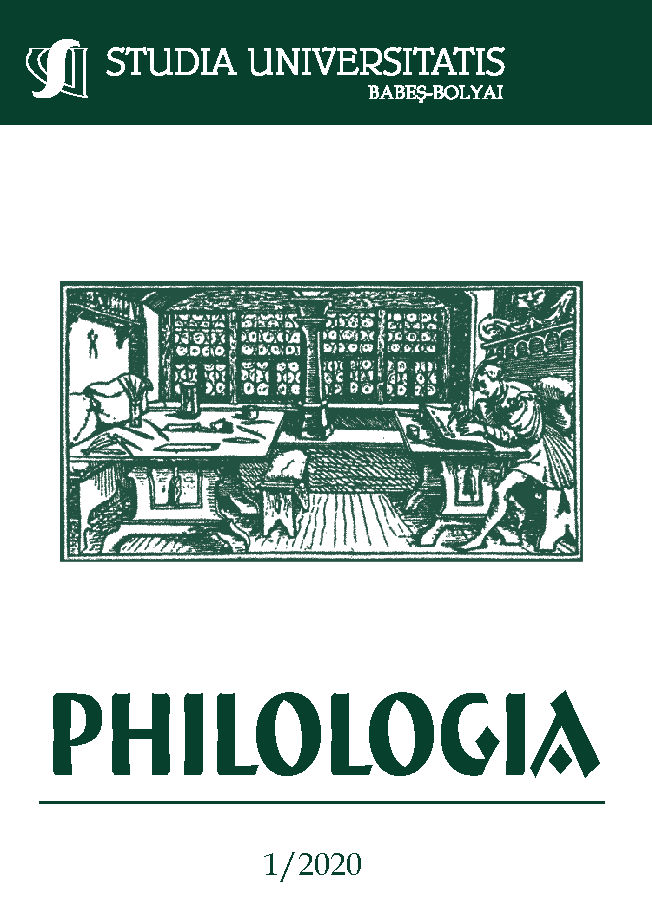THE MASK AVATARS IN THE WORKS OF MISHIMA YUKIO AND ROLE PLAYED BY THE SUBJECT-OBJECT RELATION
DOI:
https://doi.org/10.24193/subbphilo.2020.1.02Keywords:
Autobiographical Fiction, Modern Japanese Literature, Narrative PerspectiveAbstract
The Mask Avatars in the Works of Mishima Yukio and Role Played by the Subject-Object Relation. In understanding the autobiographical aspects present in the works of Mishima, addressing the Subject-Object relation is essential – a relation implicitly suggested and justified by the term mask used in the title Confessions of a Mask. The present paper shall try to analyse the variations of the functioning mechanism of this relation in Confessions of a Mask (Kamen no kokuhaku/ 仮面の告白, 1949), The Temple of the Golden Pavilion (Kinkaku-ji/ 金閣寺, 1956) and The Sea of Fertility (Hōjō no Umi/ 豊饒の海, 1965-1970). Moreover, with respect to the dialectics of the Subject-Object relation, we shall identify the mask avatars that, on an epic level, produce a real hallucinating effect, by hiding and, at the same time, revealing the intentions of the hero and/or of the author. The face, the appearance and the make-up as avatars of the hero’s mask are also expressions of the narrator’s identity, thus creating the illusion that, in Confessions of a Mask, we are not faced with the referentiality of language in the name of which the textual world is constructed, but the inner reality of the author himself. The narrator fades behind the mask in order to create the effect of reality: the illusion of the presence of the Author. A true master of the mask, Mishima Yukio gives the readers the illusion that they are facing the author himself, when, in fact, they are merely taking part in a cleverly staged game.
REZUMAT. Avatarurile măștii în opera lui Mishima Yukio și rolul raportului Subiect-Obiect. Pornind de la ideea că, în înțelegerea aspectelor autobiografice ale operei lui Mishima este esențială punerea în discuție a raportului dintre Subiect-Obiect, raport pe care, implicit, îl sugerează și îl justifică cuvântul mască din titlul Confesiunilor unei măști, vom încerca să analizăm variațiile mecanismului de funcționare a acestui raport în Confesiunile unei măști (Kamen no kokuhaku/ 仮面の告白, 1949), Templul de aur (Kinkaku-ji 金閣寺, 1956) și Marea fertilității (Hōjō no Umi/ 豊饒の海, 1965-1970). De asemenea, în raport cu dialectica relației Subiect-Obiect, vom identifica avatarurile măștii care produc în plan epic un efect halucinatoriu de real, ascunzând și, simultan, demascând intențiile eroului și/sau autorului. Fața, chipul și machiajul ca avataruri ale măștii eroului sunt totodată expresii ale identității naratorului, dându-ne iluzia că, în Confesiunile unei măști, nu ne confruntăm cu referențialitatea limbajului în virtutea căreia se construiește lumea textului, ci cu realitatea interioară a autorului însuși. Naratorul se estompează în spatele măștii pentru a crea efectul de real: iluzia prezenței Autorului. Adevărat maestru al măștii, Mishima Yukio dă cititorului iluzia că care are de-a face cu autorul însuși, când, de fapt, nu participă decât la un joc abil înscenat.
Cuvinte-cheie: ficţiune autobiografică, literatura japoneză modernă, narativitate
References
Frenţiu, Rodica. 2010. “Yukio Mishima: thymos beetween aesthetics and ideological fanaticism”. In Journal for the Study of Religions and Ideologies. Vol. 9 (25, Spring), 69-90.
Keene, Donald. 2003. Five Modern Japanese Novelists. New York: Columbia University Press.
Nathan, John. 2004. Mishima. A Biography. Tokyo: Tuttle Publishing.
Mishima, Yukio. 1958. Confessions of a Mask. Translated by Meredith Weatherby. New York: New Directions Publishing Corporation.
Mishima, Yukio. 1994. The Temple of the Golden Pavilion. Translated by Ivan Morris, London: Vintage International.
Mishima, Yukio. 1972. Spring Snow. Translated by Michael Gallagher. New York: Alfred A. Knopf.
Mishima, Yukio. 1973. Runaway Horses. Translated by Michael Gallagher. New York: Alfred A. Knopf.
Mishima, Yukio. 1973. The Temple of Dawn. Translated by E Dale Saunders, Cecilia Segawa Seigle. New York: Alfred A. Knopf.
Mishima, Yukio. 1974. The Decay of the Angel. Translated by Edward Seidensticker. New York: Alfred A. Knopf.
Pollak, David. 1985. “Action as Fitting Match to Knowledge. Language and Symbol in Mishima's Kinkakuji”. In Monumenta Nipponica. Vol. 40 (No. 4, Winter), 387-398.
Swann, Thomas E. 1972. “What Happens in Kinkakuji”. In Monumenta Nipponica. Vol. 27 (No. 4, Winter), 399-414.
Downloads
Published
How to Cite
Issue
Section
License
Copyright (c) 2020 Studia Universitatis Babeș-Bolyai Philologia

This work is licensed under a Creative Commons Attribution-NonCommercial-NoDerivatives 4.0 International License.





 ©Studia Universitatis Babeş-Bolyai Philologia. Published by Babeș-Bolyai University.
©Studia Universitatis Babeş-Bolyai Philologia. Published by Babeș-Bolyai University.